How to uninstall your current display drivers
Vista info HERE
Unfortunately, Microsoft changed things in Vista and I'm not currently running it. So, I have no experience uninstalling display drivers under Vista. But from what I've read, the "Add/Remove Programs" process described below has changed a bit. There's more than one way to start the Vista version of add/remove but the one which works for everyone (apparently) is to open "My Computer" and then click the "Uninstall or change a program" item which appears towards the top of the window. That should bring up the new version of the add/remove window. Then click the display driver to select it as described below in "Uninstalling with Add/Remove Programs" and then click the "Uninstall button".
Why you should uninstall
You should always uninstall your current display drivers before installing new display drivers. If you install new drivers over the old ones, parts of the old drivers can be left around and cause problems. You can usually install new ones over old ones without getting into trouble. But when things go wrong, it may not be the least bit obvious what is causing the problem. It causes misery often enough that there are specialized programs like Driver Sweeper and ATI's Catalyst uninstaller which try to eliminate all vestiges of any leftover display drivers.
Before starting the process of changing display drivers, it's a good idea to create a restore point as described here. That way, if something goes wrong you can undo the changes you just made. You should always have administrator privileges before uninstalling drivers (instructions here).
Uninstalling with Add/Remove Programs
The easiest and most reliable way to uninstall display drivers is with the "Add/Remove Programs" window. This should always be the first method you try. All but the most ancient drivers from NVIDIA and ATI can be removed this way. Most other recent display drivers can also be uninstalled in "Add/Remove Programs".

To use the add/remove approach, open the "Control Panel" and then double-click "Add/Remove Programs". In Windows 95, 98, and ME, select the "Install/Uninstall" tab. Then for all versions of Windows, find the entry for your display drivers and click it. The entry is usually the name of the manufacturer of the GPU on your display adapter followed by "graphics driver" or "display driver". Then just follow the prompts and remove the driver. You will then be asked to restart Windows.
If your display driver doesn't support "Add/Remove Programs" then you have to use one of the other approaches: if you're running Windows 95, 98, or ME, then you install the standard driver; or if you're running Windows 2000, or Windows XP, you uninstall the driver in the "Device Manager".
Uninstalling NVIDIA drivers with Add/Remove Programs
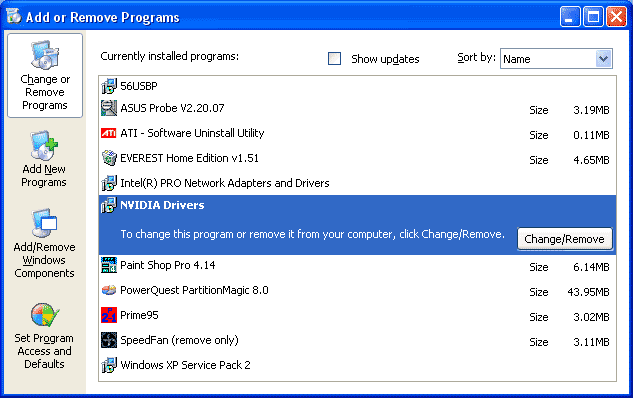
If you see an entry which says "NVIDIA Graphics Drivers" or "NVIDIA Display Drivers" then select it and remove it. But sometimes NVIDIA display drivers appear as "NVIDIA Drivers" as seen above. This version appears because NVIDIA makes more than just display adapters. They also make motherboard chipsets which means that there is more than one kind of NVIDIA driver which can be removed in "Add/Remove Programs". If you see something like "NVIDIA nForce Drivers", don't remove them. Those are motherboard chipset drivers. In the case shown above, just select "NVIDIA Drivers" and click the "Change/Remove" button.

If the only NVIDIA driver installed is a display driver, then it will ask you to verify if you want to remove your display driver.

If there is more than one NVIDIA driver, then it will allow you to select which drivers to remove. Click "Remove only the following" and then make sure that only "NVIDIA Display Driver" has a check to the left of it. Click "Remove" and then it will uninstall your display driver and leave the rest of the NVIDIA drivers installed.
If you have more than one NVIDIA display adapter installed in your computer, removing the display driver will remove the drivers for all display adapters which are using it.
Uninstalling ATI drivers with Add/Remove Programs

When uninstalling ATI drivers using "Add/Remove Programs", you may have an entry for "ATI - Software Uninstall Utility". The uninstall utility removes the ATI control panel or ATI catalyst control center, the ATI display driver, any ATI demos, and the uninstall utility itself. This utility is the easiest way to uninstall the ATI software. Just select the uninstall utility, click the button, follow the prompts, and then reboot.
If you don't have the uninstall utility then you should have the "ATI Display Driver". You probably also have either the "ATI Control Panel" or the "ATI Catalyst Control Center". First uninstall the "ATI Control Panel" or the "ATI Catalyst Control Center" if you have either of those. You will be prompted to restart the computer but you can cancel out of that. Then uninstall the "ATI Display Driver".

If you have more than one ATI driver installed, then a window will ask you to select which driver to uninstall. In this example, both drivers are installed for a single Radeon 9700 Pro video card. The "Radeon 9700 PRO" entry is the output for the main monitor and "Radeon 9700 PRO - Secondary" is the output for the secondary monitor. Both drivers are listed even if you're only using one monitor. You should uninstall both of them. If you have any other ATI display adapters in the computer then they will appear in this list as well. Put a check to the left of all of the display drivers and then click "OK" and follow the prompts and reboot.
If you have Catalyst drivers installed but for some reason you cannot remove them in "Add/Remove Programs", you can download a copy of the ATI Catalyst uninstaller utility from ATI's support site. Unfortunately I can't give you a direct link to the utility anymore because the morons at ATI decided to prevent links into their support site. You'll just have to navigate their labarynthine website on your own. Start here and click the "Customer Care" link at the top of the page. If a drop-down menu appears when you move the mouse over "Customer Care" then just ignore it and click "Customer Care" at the top. Type "catalyst maintenance utilities" into the search box in the upper left part of the window and then click the "GO" button. Look in the search results for the "CATALYST - ATI Maintenance Utilities" link and then click it. Click the "cat-uninstaller.exe" link to download the utility. The only difference between this utility and the "ATI - Software Uninstall Utility" in "Add/Remove Programs" is that the downloaded version does not uninstall itself.
Uninstall in the Device Manager in Windows 2000 or XP
Windows 2000 and XP display drivers are normally removed in the "Add/Remove Programs" window but some drivers may not work that way. You can also have damaged installations which should appear in "Add/Remove Programs" but do not. In cases like that, you can uninstall the driver in the "Device Manager". This approach only uninstalls the display driver itself and not any supporting programs like control panels, so it should only be used if you can't do it in "Add/Remove Programs". To use this method, open the "Control Panel" and then double-click "System". Select the "Hardware" tab and click "Device Manager". Then click the "+" to the left of "Display Adapters" to show the installed display adapters.

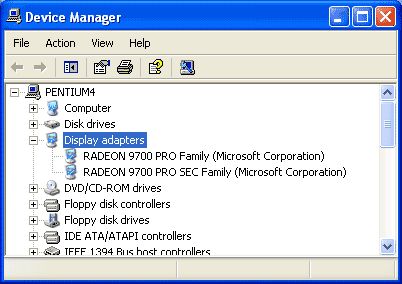
In both examples above, the installed drivers are actually drivers provided by Microsoft. This kind of display driver does not need to be uninstalled like a normal one. It doesn't hurt to uninstall it, but it isn't necessary. If you're not sure whether it's a Microsoft display driver then just go ahead and uninstall it. To uninstall the driver, right-click it and then select "Uninstall". The Radeon 9700 Pro shown above has two monitor outputs. The "Radeon 9700 PRO Family" driver is the main monitor output and the "Radeon 9700 PRO SEC Family" driver is for the second monitor output. You should uninstall the driver for both outputs.
Change to the standard driver in Windows 95, 98, or ME
If you can't use the "Add/Remove Programs" method in Windows 95, 98, or ME, then you have to uninstall your current display driver by installing a default driver to replace it. Open the "Control Panel" and then double-click "Display" to bring up the "Display Properties" window. Select the "Settings" tab, click "Advanced", and then select the "Adapter" tab.
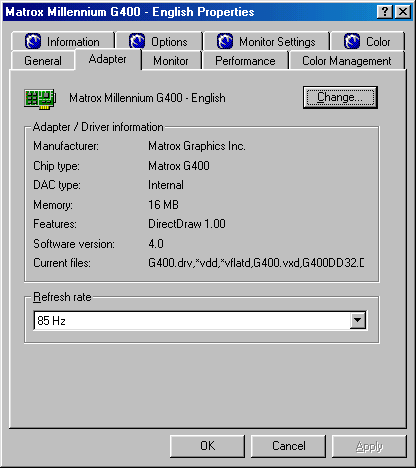
That displays the information about your current display adapter. Click "Change" to start the "Update device driver wizard".
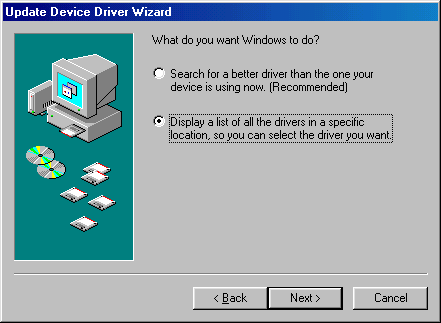
Click "Next", select "Display a list of all drivers in a specific location...", and then click "Next" again.
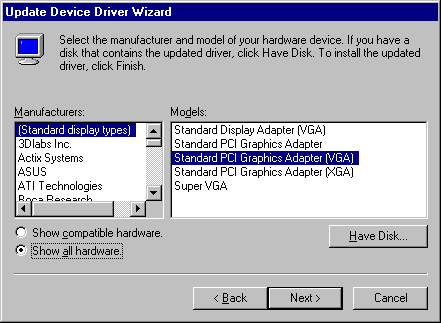
Select "Show all hardware" and then click on "(Standard display types)" which is at the top of the list on the left. Then click "Standard PCI Graphics Adapter (VGA)" in the list on the right unless you're using a REALLY old computer with an ancient ISA video card in which case you should select "Standard Display Adapter (VGA)" (and run out and buy a new computer). This tells Windows to load up a generic display driver which also unloads your current driver. Click "Next" twice and then "Finish" and then reboot Windows. Once Windows has rebooted, you should be operating with a generic display driver.
Dealing with uninstall problems
It's a good idea to be thorough when you're uninstalling display drivers before changing video cards or before updating your drivers. Unfortunately, sometimes things go wrong. Perhaps you forgot to uninstall your old drivers before installing new ones, or maybe your computer crashed while changing drivers. Whatever the cause, you may have parts of leftover display drivers in your computer which are difficult to get rid of. You can use a program called Driver Sweeper to try to clean out leftover drivers. It's a free program which can clean up ATI and NVIDIA display drivers for Windows 2000, Windows XP, and Windows Vista.

If "Add/Remove Programs" successfully uninstalled your display drivers, then you don't need to run Driver Sweeper unless you like to be extremely thorough. Most people don't run this kind of program unless they are having problems with their display drivers. You should always uninstall your display drivers using one of the methods above before running Driver Sweeper. It is not a full uninstaller. It just gets rid of things which may be left over from a regular uninstall. What follows is a general description of how to use Driver Sweeper. The program contains help information which you should read before using Driver Sweeper to clean things up. The help information may contain instructions which apply to your specific situation.
To uninstall a display driver using Driver Sweeper, the first step is to uninstall the display drivers using one of the methods described above. Try "Add/Remove Programs" first. If you can't uninstall that way then try to use one of the other methods. But when your system restarts, boot in safe mode (instructions here) rather than booting normally. At that point a "Found New Hardware" window may try to install new display drivers. Cancel out of that if you're given the choice. If you can't cancel out and it installs a display driver, then uninstall that display driver in the "Device Manager" as explained above except uninstall the driver even if it's a Microsoft driver and don't allow it to reboot. The goal here is to get into safe mode with only the default VGA driver installed. Windows 2000, XP, and Vista sometimes install drivers for you anyway so you need to try to stop them. Once you are in safe mode disable any anti-virus scanner you have running and run Driver Sweeper.

Go to the "select" box on the left and click on the driver you want to sweep. Select "ATI - Display" for ATI video cards or select "NVIDIA - Display" for NVIDIA video cards. Don't select "NVIDIA - Chipset" because it's designed to sweep chipset drivers for motherboards with NVIDIA chipsets. Once you've clicked on the driver to sweep, click on the ">" button. Then the selected driver will show up in the "Remove" box on the right. If you've selected the wrong one then click the "<<" button and it will remove it from the "Remove" box. Once the "Remove" box shows the driver you want to sweep, click the broom icon at the upper left of the screen. It will ask if you want to continue before cleaning up what's left of that driver. A progress bar below the "Select" and "Remove" boxes displays the progress of the cleaning. It usually goes by pretty quickly.
If the uninstall which you did just before rebooting into safe mode was succesful, then reboot and you're done. But if that uninstall had problems or you couldn't do it, then you may have a little tidying up to do. If you had an uninstall problem, then when you reboot you should go look in "Add/Remove Programs" and see if any things related to your display drivers are still in the list. There probably won't be anything but if there is, then try to remove them one last time. You should also go into the "Device Manager" and look for display drivers. After Driver Sweeper runs they may show up as disabled. Uninstall them as described above. There may be one or more reboots to go through this tidying up process. Your goal is to eliminate any signs of the old display drivers or supporting programs like control panels.

